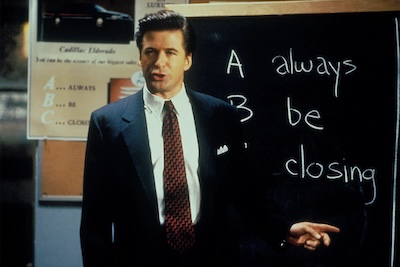Millions of audience members could hum or sing you the score of Stephen Schwartz’s Wicked. There is a reason why it is one of the longest-running and most celebrated musicals of all time, after all, but adapting this sensation for the big screen posed a very specific and exciting challenge: what kind of music accompanies this fantastical tale of love and friendship? Director John M. Chu turned to composer John Powell, and the collaboration, along with Schwartz, is an inspiring one. The worlds of Munchkinland, Shiz University, and Emerald City–as well as the emotional arcs of the characters–are underscored with wondrous beauty, intelligence, and whimsy.
Powell’s first introduction to the megahit musical was when he sat down to watch a cut of the movie. Imagine seeing this fantastical realm but not hear any music other than the original songs. What stood out to him, though, was the bond between its two lead characters.
“The only music that was in the cut that I saw were the songs, so, basically, there was nothing underscoring anything,” Powell says. “I had to wait three days to see part two, so I didn’t know anything about the story other than ‘Popular’ and ‘Defying Gravity.’ I may have heard some of the other music, but I didn’t have them in my brain. I just thought that it was one of the most amazing love stories I’d ever seen.”
One might wonder how a composer invokes the original mood or style of an established musical. Would the music feel too separate from the beloved songs? In order for Powell to understand Wicked‘s original score on a deeper level, he turned to guidance from Schwartz himself.
“I had three days working with Stephen, and I asked him to remember every detail he could of how he constructed the musical,” he says. “I wanted to know about the shape of the melodies and the harmonic language, so we did a sort of boot camp on it. We analyzed the themes as he understood them, what they were there for and, as he would talk, he would play and I’d play. I got an insight into the original inventions that were going on in his brain–it’s very thoroughly composed and classically structured. I was trying to amplify everything that John Chu had seen when he saw the musical on stage when he was 22.
We were trying to retrace the harmonic language that he uses, and Stephen is a brilliant piano player. He doesn’t like thirds. If you use thirds at the bottom, mix it with these little idiosyncrasies about it. There’s also sort of a commonality in certain types of language. I can hear a lot of Burt Bacharach, so the elegance of his kind of harmonic invention is kind of Stephen’s harmonic line. There’s someting about his melodic shapes and progressions that I wanted to learn about.”
It’s important to look at the differences between a musical on stage versus a musical on the screen. A film adaptation allows the story to explore more interiority, and that extends to the music as well. A tender measure of piano can reinforce Elphaba’s longing or, conversely, bounce around to show Glinda’s impatience. Powell was inspired by another admired musical adaptation to make this leap.
“John Chu hired somebody who wasn’t from musical theater specifically,” Powell says. “I wanted to make Wicked like Fiddler On the Roof, and that was done by John Williams. That film was definitely a film version of the stage show, but it was in such a grand language that was supported in such a grand way because the visuals were there. You don’t have the intimacy of the close-up on stage, so the music has to work in a very different way. There’s a language in cinema, remember, which is the camera. The perspective is incredibly important.”
Powell’s score showcases Elphaba’s intelligence and hunger for knowledge, but it also underscores Glinda’s perky demeanor. Powell’s score is incredible at reinforcing a character’s arc or what a character wants you to think about them. For someone like Jonathan Bailey’s Fiyero, Powell lets the strings bounce as if the character is even flirting with the audience while extending a romantic flair. We fall in love with him immediately.
“Stephen kept saying that we had to establish Fiyero as a different character from everyone else,” he says. “We tried all sorts of things, and once we had him arriving in the forest, that kind of settled down a bit. We couldn’t use a lot of ‘Dancing Through Life,’ becauise it’s about to come in, and it’s a long sequence. With him flirting, I actually thought about The Crown, because there’s a lot of good music in there where it represents not the person but the image and the institution. With this, this is the institution of somebody who is desired by everybody–not just because of how he looks but of who he is. I wanted to interpret that but take it ridiculously over-the-top.”
A pivotal moment in the film, and in Elphaba and Glinda’s friendship, comes when Elphaba decides to join her fellow students at the Ozdust Ballroom. Wearing her soon-to-be-iconic hat, the music reflects Elphaba’s loneliness. A piano stroke at the beginning almost sounds like Elphaba’s heart dropping when she realizes how Glinda tricked her, but it soon morphs into a defiantly quiet, echoing choir.
“There are some very hard scenes to look at when everyone’s putting it together,” Powell says. “A lot of the dance is in silence and intentionally awkward, but it’s really a scene about betrayal. Once the silence was set, we had to establish how we were going to get back into the resprise of ‘Dancing Through Life’ since that scene closes.
I wrote a new tune which is called the ‘Green Toy Tune,’ because John had been saying at that in the moment where The Wizard shows her the green toy, it’s the first time that she’s seen herself as authentic, so I popped out a tune that was very inspired by that and the language of Stephen. It had to be unique, though, and then we realized that we needed to go back and put that all the way through the movie. We changed lots of cues and re-established that.”
Wicked is available to rent and own. You can listen to John Powell’s score of the film on Spotify and Apple.





![‘The Four Seasons’ Scene-Stealer Marco Calvani On His Return to Acting [VIDEO]](https://thecontending.com/wp-content/uploads/2025/04/4season-120x86.jpg)




